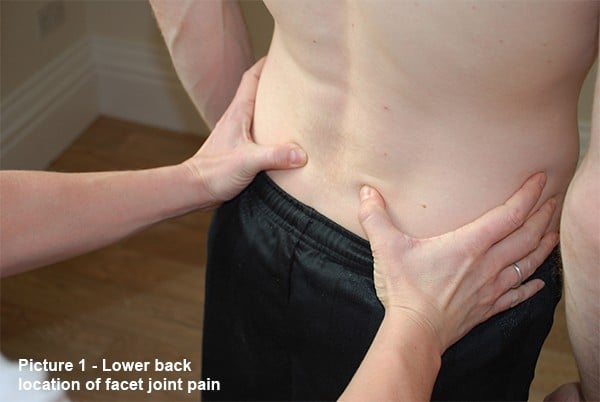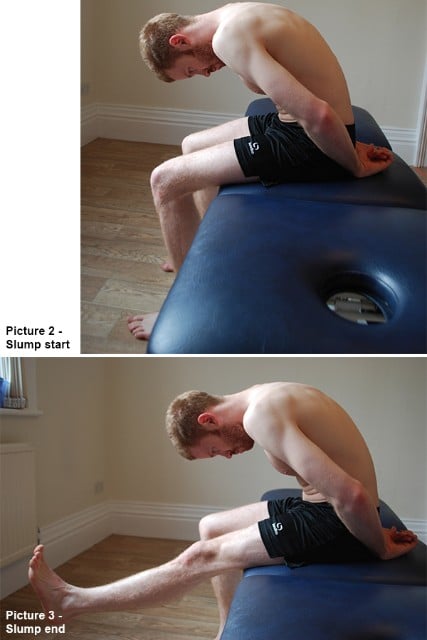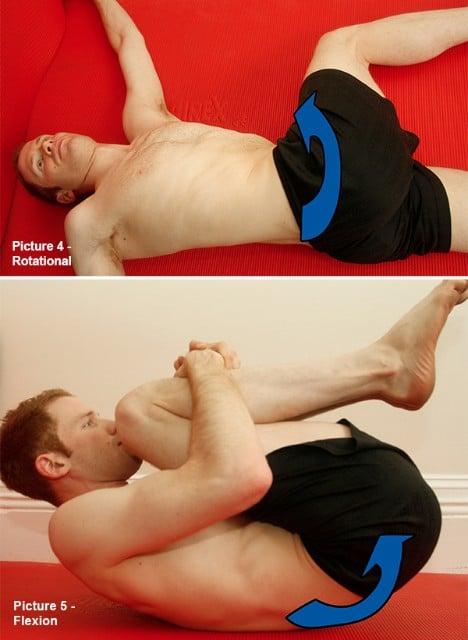Facet joint pain is pain felt at the joint between two vertebrae in your spine. Find out about the symptoms, tests and treatment for the problem.
What happens to cause facet joint pain?
These are the two joints at the back of each of the vertebrae of the spine which slide and glide to allow flexion or extension (forward or backwards bend). They can become bruised and inflamed as well at ‘caught’ on themselves either from stiffness or actual locking or through spasm of the muscles surrounding them.

Common causes are sudden lifts or twist in awkward positions. Look at it like a twisted ankle as the mechanism is the same.
How to test them
These are often more painful to bend backwards than forwards and have one direction of movement which is particularly painful due to being stuck. e.g. back and to the left. They are generally comfortable when resting but sore to move.
Distribution of facet joint pain
They are mostly painful in the back only – usually to one side and do not refer much further than into the bum area. There is not often much nerve symptom.
If you can bend forward relatively comfortably but get a sharp twinge when bending backwards or to the side this is more facet like.
Using the Slump Test , you can check out the nerve itself.
Sit with your leg over the edge of a chair and put your arms behind your back and chin on your chest. Curl your upper and lower back forwards so you are slumping. Point your foot and slowly straighten your knee. When it reaches as far as it can slowly pull your toes up towards you.
You should feel a pull in the back of the knee, bum and sometime base of the back.
Keeping the leg static slowly look up towards the ceiling. The pull in the leg should disappear.

Compare it to the other side. The range the leg goes to before pain, the location of the pain and the change when looking at the ceiling should all be pretty much the same.
If they are then this is normal and shows the nerve is happy.
If you have a completely different pain or pull distribution and the range is much shorter (more than 10%) and it recreates your pain then the nerve is unhappy and there might be a disc issue as well. Please read the 'Disk Problems' article for more information.
How to treat them
The solution to the acute stage is to get the spasm in the muscles surrounding the joint to relax as much as possible and then restore movement to the joint.
Start with heat and relaxation, preferably in lying, to allow things to calm then work through the exercises to rotate and flex the spine. These need to be eased into and not forced. Gentle rocking and stretching is the best approach.

Once you can restore the movement then it is essential to keep moving the back despite things being sore for a few days. The back will inevitably stiffen overnight and easing into the exercises will help this alongside further heat (hot water bottle/heat pack/hot bath).
The bruising and inflammation takes a few days to settle, much in the same way as a sprained ankle. Over the counter anti-inflammatory and pain killing drugs are helpful but make sure you read the leaflet/label.
Generally, this type of low back will take a week to 10 days to ease up. The first 4 days are usually the worst. If it lasts for more than a week or so without improvement then please seek some help from your physio.
Physio treatment for facet joint pain
This will comprise of assessment to determine the exact cause and then treatment and advice. Your physio will generally use manual therapy to mobilise the muscles and joints, possibly with a manipulation or ‘crunch’ to free a particularly stuck joint. There will be advice on care and some specific exercises for you to work on the joints yourself.
For more information on lower back pain injuries, visit our 'Introduction to lower back pain' article.















